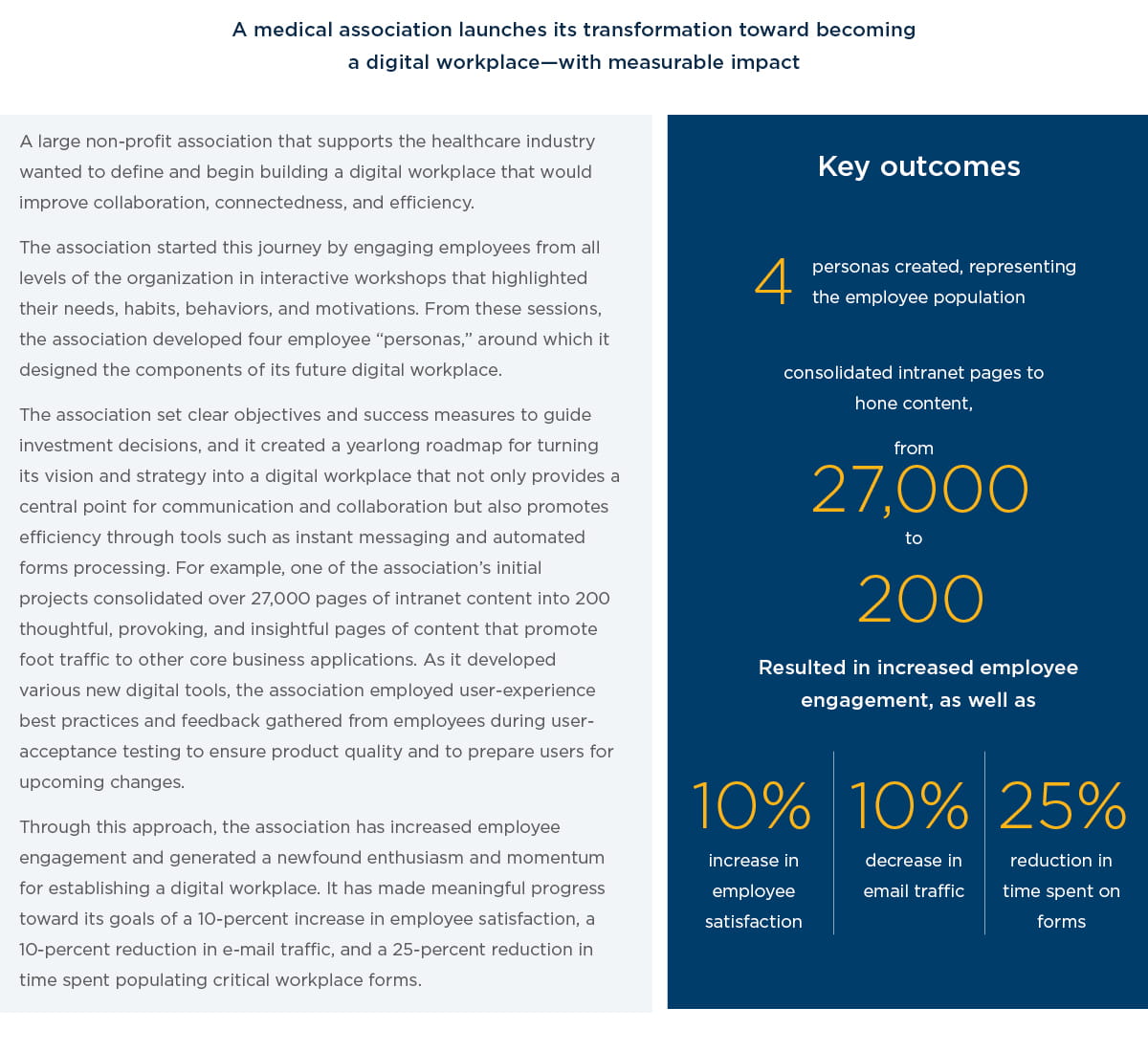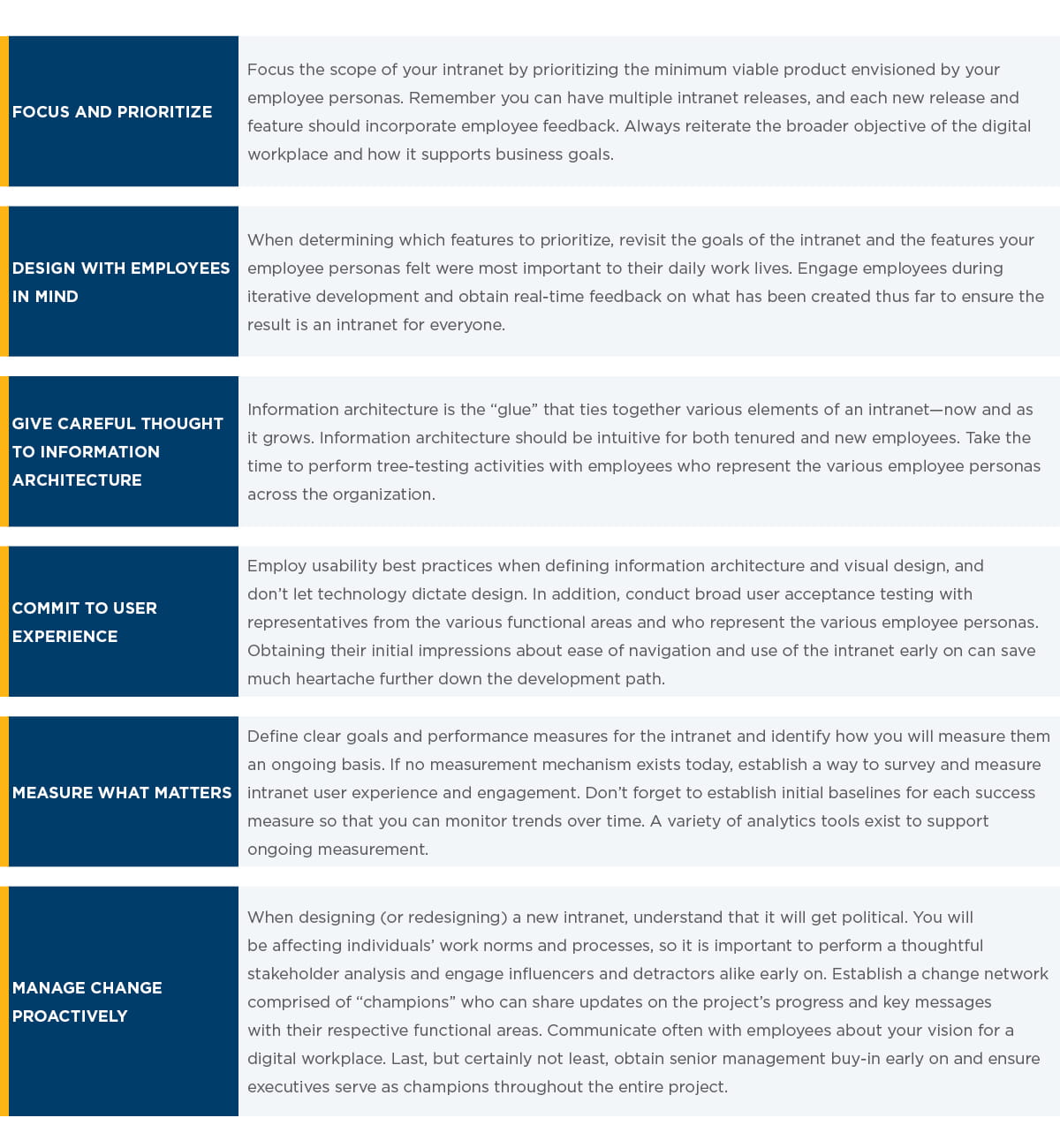
January 2017 | Point of View
Digital workplace strategies for the modern employee
Digital workplace strategies for the modern employee
Millennials comprise a growing percentage of the workforce—to which they bring expectations very different than the generations before them. One of those expectations is that they will be able to leverage the same modern digital capabilities that shape their personal lives to perform work and establish meaningful connections with and within their organizations. These expectations, along with other factors, are driving the evolution of a digital workplace.
Many organizations struggle with transforming their workplace to attract, engage, and retain millennial workers. ”
This article reviews research about millennials’ expectations, discusses evolution of the workplace from physical space to interconnected digital space, and outlines three practical steps for initiating and accelerating the digital workplace journey: understanding employees, building a thoughtful digital workplace strategy, and jump-starting the journey through development or revitalization of the company intranet that makes information more accessible.
Millennials: not as engaged as we want and need them to be
Although we frequently hear of millennials being upbeat altruists who make the most of every situation, recent studies paint a gloomier picture of disengagement, job-hopping, flight risks, and survival. As highlighted by Forbes, a recent Fusion 2016 Issues/Washington Post poll found the percentage of young Americans who believe the American Dream "is not really alive" increased dramatically over 30 years, from 12 percent to 29 percent.
In fact, Gallup's staggering statistics reveal that only 29 percent of millennials are engaged at work, with 6 in 10 millennials noting they are open to different job opportunities, and only 50 percent planning to be with their company a year from now.
These troubling figures should be a wake-up call for any organization seeking to grow, be more productive, and deliver a strong customer experience.
Understanding millennials’ workplace expectations
Each new generation brings new and great expectations to their work, and millennials are no different. To ensure a strong economy, employers cannot ignore millennials’ expectations. Currently, millennials comprise 38 percent of the U.S. workforce, and estimates suggest that these young Americans will dominate the workforce by 2025 by making up 75% of the working population.
Many studies have attempted to understand what this emerging generation is seeking in the workplace, and some consistent themes have arisen from various studies.
Purpose and priorities. Millennials want more clarity about their role, greater awareness of their purpose within the organization, and an understanding of the broader purpose they are serving within society. Having a clear sense of purpose is more important than an egregious income. More tactically, as compared to other generations, millennials are struggling to understand what they need to do when, with nearly half of millennials not feeling as though they know how to prioritize responsibilities at work.
Meaningful connections. Millennials are avid users of social media, and their friends’ recommendations, at times, mean more to them than trusted news sources. This generation is hyper focused on building a sense of community, where “FOMO” (fear of missing out) is a real concern. As employees, they seek an environment where they can connect on a deeper, more personal level with their colleagues, and they want their leaders to be coaches who care about them holistically as people.
Empowered development. Nearly 90 percent of millennials rate “professional or career growth and development opportunities” as important features of a job. They seek out organizations and leaders that give them the space to learn and grow and while providing them with the necessary feedback and guidance along the way.
Balanced life. Millennials comprise one of the healthiest generations, and their focus on wellbeing extends to their desire to integrate work into their life. Millennials are known for their unwillingness to sacrifice their lives outside of work, and this reluctance is challenging employers to identify flexible and unique ways to support more balanced, healthy lifestyles through remote work and options such as flextime.
Social responsibility. Millennials seek out employers that care about the broader issues troubling our society, and they want to quickly become involved with a firm’s philanthropic efforts. According to a recent Forbes survey, 80 percent of thriving entrepreneurs under the age of 30 are already active in their communities outside of work.
The evolving workplace: from physical space to digitally interconnected space
Why is today’s workplace experience missing the mark so widely with the population of employees who will soon dominate the workforce? One key factor is a large gap between employees’ expectations for a modern, digitally enabled work environment and the tools they are provided today to perform their jobs.
As employees experience what it’s like to be a customer of a digitally savvy retailer, or as they consume the numerous features of social media titans Facebook and Instagram, they develop specific beliefs of what should be possible as an employee tasked with completing job responsibilities.
These emerging expectations—together with imperatives around efficiency, customer centricity, and the use of organizational data to drive success—are pushing employers to evolve the concept of “workplace” from a physical site to a digitally interconnected space.
What is a digital workplace?
A successfully interconnected digital workplace provides employees with an environment and tools that allow them to work effectively and efficiently and to choose how they want to interact with colleagues—and from where.
Every digital workplace will look and feel different because it derives from a unique culture, operations, and collection of individuals. That said, it should contain core components like:
- Business process tools and systems that are core to how the organization functions (e.g., learning management system, time management system, customer relationship management system, performance reporting)
- Collaboration sites that serve as a central point for intra-departmental collaboration (e.g., department sites that enable knowledge sharing)
- A company-wide intranet that serves as a hub for company-wide communication and information-sharing
- Messaging tools that connect employees (e.g., email, instant messaging, teleconference)
- Custom applications and productivity tools (e.g., forms engine)
Over time, the number of components will grow. As it does, mindful expansion is important in order to minimize maintenance burdens and to enable efficient integration of new capabilities and continuous and effective growth of the digital workplace.
Benefits of a digital workplace
A digital workplace has a variety of benefits. For one, it equips employees with tools that allow them to be more effective and productive— employees can work smarter, engage better with one another, learn and discover new and improved work patterns, and see the impact of their work on the company’s culture and success.
Although higher employee engagement and satisfaction tend to be cornerstones of an effective digital workplace, organizations have seen various other tangible benefits. Firms find that employees become more self-reliant, reducing the amount of upkeep required from support centers. Employees also tend to have greater access to effective training and work tools that increase productivity and efficiency. To further underscore the importance of employee engagement and satisfaction, Gallup’s recent analysis shows that business units in the top quartile of employee engagement are 17 percent more productive, have 10 percent better customer ratings, and are 21 percent more profitable compared with business units in the bottom quartile. The analysis goes so far as to state that highly engaged companies are two times more successful.
Three steps and initiatives toward building a digital workplace
Despite the compelling benefits, many organizations struggle to get their digital workplace journey off the ground. Often, this is an issue of focus and clarity on how and where to begin, particularly given the complex and rapidly evolving nature of digital technology. Starting small, with discrete and manageable efforts, can deliver tangible quick wins and generate momentum for change, as illustrated by the case study below. Following are three steps that can help your organization in creating an engaging digital workplace.
Following are three steps that can help your organization build toward an engaging digital workplace.
1. Know your employees.
Just as organizations build market-facing digital strategies around the needs and preferences of their customers, they must build digital workplace capabilities around the needs, motivations, and work patterns of their people. Understanding for whom this digital workplace is being built will help you design a workplace that reinforces your organization’s culture and truly works the way your people expect it to.
A broad-reaching preliminary survey followed by in-depth interviews with employees representing a cross-section of functional areas can help you uncover employee “personas” that exist within your organization. These employee personas serve as design archetypes and reference points as you create a digital workplace strategy.
To make sure personas characterize your employee population in a meaningful way, they should incorporate as much descriptive information as possible about:
- Demographic profile (e.g. tenure, tech- savviness)
- Job description details
- Work preferences
- Current frustrations with the workplace
- Ideas for the future state of your digital workplace
2. Define your digital workplace strategy.
Developing a clear strategy is key to sustaining focus on goals and engaging others in this evolutionary journey. Start with your organization’s overall business strategy—how can a digital workplace directly influence business goals and outcomes? For example, by providing employees with new self-service tools, you may enable them to answer questions faster and improve the customer experience. Then, to refine the requirements and priorities for your digital workplace, hold focus group with individuals who represent the various employee personas to gain their ideas for delivering key business outcomes.
Set goals for what you want the digital workplace to accomplish, but don’t stop there. It is also important to have measures of success. If your goal is to increase employee engagement and satisfaction, then define how you will measure it—for example, through a 10-percent increase in the average employee engagement score on the annual employee engagement survey.
Based on your goals, you can then create a vision for all foreseeable technology upgrades, any required modifications to physical space, and adjustments to processes and practices that will require a concerted organizational change management effort. Your vision should be lofty, and although it won’t be attainable within one or two years, it should serve as an initial roadmap that you can continue to modify over time as your workforce shifts.
3. Begin by making information easily accessible.
Revitalizing or creating an intranet for the first time is a good digital foundation for reinvigorating and reconnecting your employee population. An effective intranet connects people with the organization’s overall mission and with one another, and it helps them see how their work impacts the organization as a whole. It also allows employees to feel valued via opportunities to share their expertise, experience, and perspectives. By tackling the intranet first, you will be establishing a hub where employees can communicate with you as you continue down your digital workplace journey.
This exercise provides the opportunity to be creative and to redefine what you may have traditionally considered to be an intranet. For example, it doesn’t have to be just about information sharing; you might also consider incorporating process automation or establishing intra-departmental collaboration centers. Whatever you choose, make sure it is reflective of your organization and culture.
Essentials for an engaging intranet
Consider these practical best practices for an intranet that can jump-start your digital workplace vision:
The digital workplace imperative is knocking at your door
The millennial workforce—our workforce of the future—is expressing dissatisfaction and remains disengaged at work. By considering this consumer-driven generation’s rising expectations with an open mind, you can begin to define an interconnected digital workplace. Start your digital workplace journey by making information readily accessible through a revitalized intranet that incorporates best practices and delivers features and functions that are important to your employees. With that as a foundation, then you will only be a leap away from a healthier workforce that is more productive, engaged, and satisfied— and motivated to deliver on your business goals.



